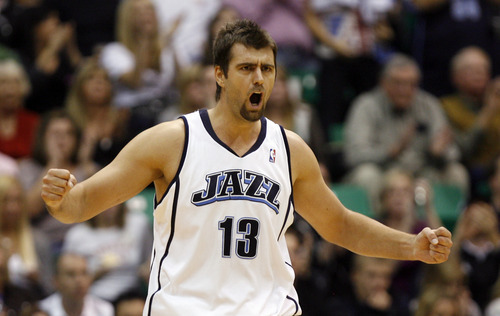This is an archived article that was published on sltrib.com in 2011, and information in the article may be outdated. It is provided only for personal research purposes and may not be reprinted.
His shooting stroke never would be labeled a quick release. That long, slow, drawn-from-the-holster motion that Mehmet Okur perfected from his signature spot at the left angle, with his toes on the 3-point line, is the reason I loved watching him launch the ball in key moments of home games.
That style of delivery gave the EnergySolutions Arena crowd enough time to build this audible buzz of anticipation as Okur took aim and fired and the ball floated toward the basket. And then, bedlam.
Those were great moments, to be relived Jan. 14 when the New Jersey — or perhaps "Eastern Utah" is becoming a better name — Nets visit the Jazz. Thanks in part to Thursday's trade for Okur, the Nets will come to town with ex-Jazz players Deron Williams, Kris Humphries, DeShawn Stevenson, Okur and, who knows, maybe even Andrei Kirilenko by then.
Okur's expiring contract with a $10.8 million salary this season made him both attractive to New Jersey and expendable for the Jazz, who are well stocked at center with Al Jefferson and rookie Enes Kanter. Yet even if Memo's role would be reduced, in his return from an Achilles injury and related issues that caused him to miss most of last season, his departure cannot occur without an expression of major appreciation from Jazz followers.
The Jazz are rebuilding and evolving lately, to a degree that's both intriguing and frightening. This is the team's 33rd season in Utah, and the Jazz have produced nine NBA All-Stars in that era. In the past 18 months, four of them have departed: Carlos Boozer, Williams, Kirilenko and Okur.
Okur is a unique player in Jazz history, as an unconventional center whose shooting skills made him an ideal complementary player in the team's inside-oriented offense. As an outside threat, he created space for Boozer and others down low, while giving Williams a bail-out option as the shot clock was running down and defenses were packing the paint.
As the Jazz became a rising team in the Western Conference, Okur averaged 17-plus points during three of four seasons, joining Boozer and Williams to give them a well-rounded offense. Beyond that, so many of his 3-pointers seemed to come at just the right times, creating huge momentum swings and deciding outcomes.
That never was more true than May 5, 2007: Game 7, Jazz at Houston. That remains the franchise's most significant moment since the 1998 NBA Finals, considering it ultimately helped propel the Jazz to the Western Conference finals, and Okur was right in the thick of it all.
In a 103-99 victory, his 3-pointer gave the Jazz the lead for good, followed by another 3-pointer that extended their lead to four in the final minute.
I'll never forget the key sequence. Okur lined up a shot from the right angle, and I said out loud, "That's not his spot." He missed, but Boozer kept the rebound alive and Okur eventually got a another try from the left angle. "That's his spot," I said, and sure enough, he delivered.
That's how I'll remember Memo, as opposed to the horror of watching him lying on the Pepsi Center court in Denver in Game 1 of the 2010 playoffs, having popped his Achilles tendon.
And yet, I'm also reminded of unfinished business. I always wanted to write the story of how that area just left of the top of the key became his sweet spot, but never did.
Okur is one of the top 15 players in Jazz history, not quite at the jersey-retirement level. But he deserves to be remembered, perhaps with a tiny No. 13 embedded in the ESA court. I could walk you to that spot, right now.
Twitter: @tribkurt



